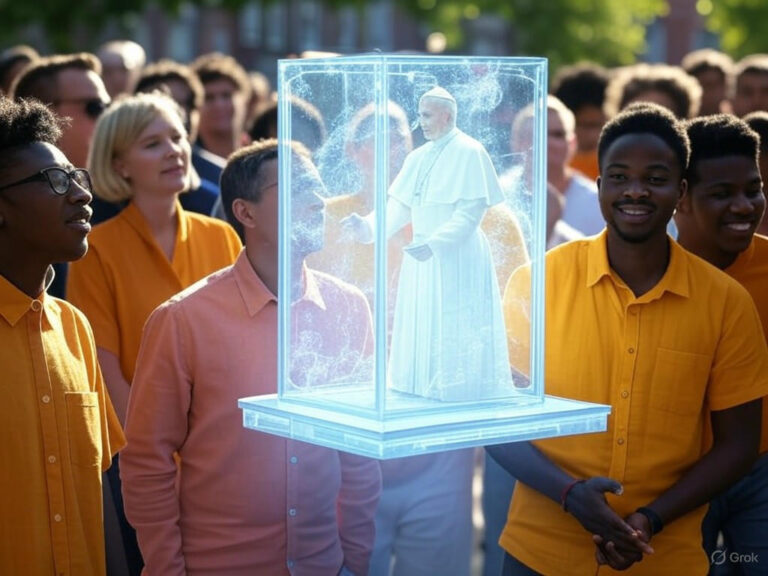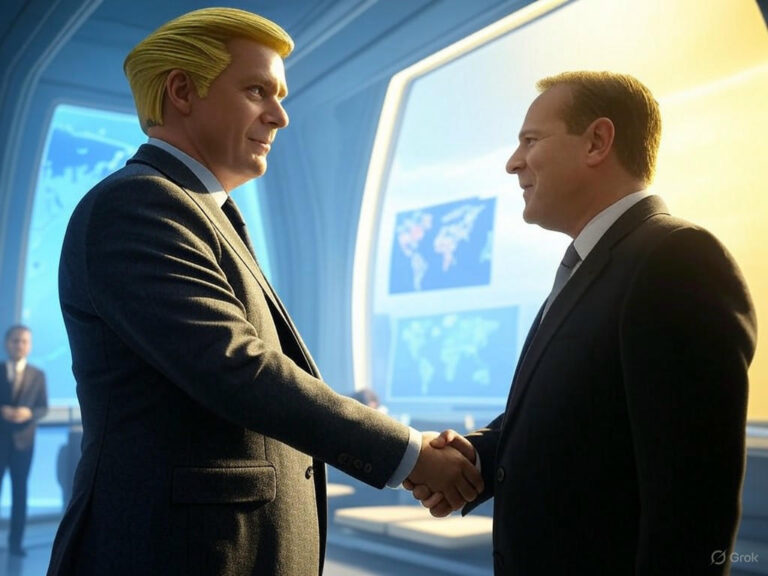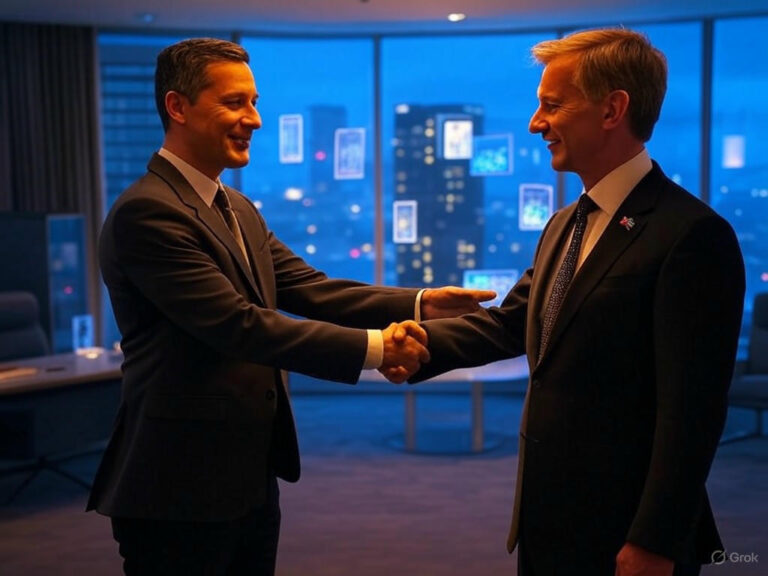
Trump AI Image as Pope Sparks Widespread Criticism
In a stunning blend of politics and digital creativity, former President Donald Trump shared a Trump Pope AI image on his Truth Social account, quickly turning heads and sparking outrage. This AI-generated depiction of Trump in papal robes surfaced just days after the world mourned Pope Francis’s passing, raising questions about boundaries in social media and respect for religious traditions. It’s a moment that highlights how quickly an online post can escalate into a global conversation, forcing us to consider the fine line between humor and offense.
The Controversy Behind the Trump Pope AI Image
The Trump Pope AI image, posted on May 2, 2025, showed Trump clad in elaborate papal attire, complete with a white cassock, miter, and cross necklace. What made this share so explosive was its timing—only 11 days after Pope Francis’s death from a stroke at age 88, during the Catholic Church’s official mourning period. Critics immediately pointed out how this image felt like a direct slight to a community still processing their loss, turning what might have been a fleeting joke into a symbol of insensitivity.
Have you ever shared something online that got more attention than you expected? Imagine the ripple effects when it’s a public figure like Trump. The White House’s decision to repost the image on its X account only amplified the controversy, blending personal expression with official endorsement and drawing even sharper rebukes from religious leaders and the public alike.
Widespread Backlash to the Trump AI Pope Image
Reactions to the Trump Pope AI image poured in from all corners, with clergy, Catholics, and everyday folks voicing their dismay. Italian and Spanish news outlets were among the first to call it out, labeling the post as poor taste and outright offensive, especially given Pope Francis’s global admiration for his compassionate leadership. This backlash wasn’t just about the image itself; it touched on deeper issues of cultural respect during times of grief.
For many, the Trump Pope AI image crossed a line by mocking a sacred role, particularly since Trump isn’t Catholic and had just attended the Pope’s funeral. Social media exploded with comments, from users decrying it as “disrespectful” to others defending it as lighthearted fun. One viral thread even remixed the image with dance beats, turning it into a bizarre meme that spread faster than wildfire—yet it only fueled the debate on whether AI tools are ready for prime-time politics.
Social Media Storm Over the Trump Pope AI Depiction
Dive into any social platform, and you’ll see how the Trump Pope AI image dominated discussions. Accounts like “Republicans Against Trump” shared it widely, calling it “full-on lunacy,” while critics nicknamed Trump a “man-child” for the stunt. On the flip side, supporters argued it was just a playful jab, but the overwhelming sentiment leaned toward outrage, especially from those who hold the papacy in high regard.
This incident makes you wonder: In an age where AI can create anything in seconds, how do we draw the line on what’s appropriate? It’s a question that’s becoming more relevant as these tools evolve, potentially reshaping how we engage with sensitive topics like religion and politics.
Trump’s Foray into Vatican Affairs and the AI Image
Beyond the Trump Pope AI image, Trump has been vocal about Vatican politics, even suggesting he’d like to be pope himself in a recent quip. He threw his weight behind Cardinal Timothy Dolan as a potential successor to Pope Francis, saying something along the lines of having “no preference” but highlighting Dolan’s strengths. Experts, however, warn that such public endorsements could backfire, given the secretive nature of papal elections designed to shield against outside influences.
Think about it—history is full of examples where overt campaigning hurt a candidate’s chances. The conclave, set to begin on May 7, 2025, is all about careful deliberation among cardinals, and Trump’s comments might just complicate things for Dolan. This blend of AI imagery and political meddling shows how tech is weaving into age-old traditions, for better or worse.
White House’s Role in Amplifying the Trump Pope AI Image
When the White House reposted the Trump Pope AI image, it shifted the narrative from a personal social media slip to something that felt institutional. This move raised eyebrows worldwide, as it came during the mourning period and seemed to endorse the depiction officially. Critics argued it blurred the lines between Trump’s personal brand and governmental communication, potentially straining U.S. relations with the Vatican.
If you’re following global politics, this is a reminder of how one digital action can echo across borders. It prompts us to think about the responsibilities of public figures in an era where every post can go viral, and perhaps even consider guidelines for using AI in official contexts to avoid such pitfalls.
Historical Context and the Trump Pope AI Image Fallout
The Trump Pope AI image landed amid a pivotal moment in Catholic history, with the Church preparing for its conclave to choose Pope Francis’s successor. This process, dating back centuries, is meant to be isolated from secular interference, making Trump’s involvement all the more jarring. The 10 U.S. cardinals, including Dolan, are set to participate, underscoring the event’s global significance.
Historically, outside pressures have often backfired, as the old saying goes: “If you enter a conclave as pope, you leave as a cardinal.” In this light, the Trump Pope AI image isn’t just a modern mishap—it’s a clash between contemporary tech and timeless rituals, highlighting ongoing tensions between politics and faith.
Patterns of AI Use in Trump’s Public Persona
This isn’t Trump’s first rodeo with AI-generated content; the Trump Pope AI image fits into a pattern of using these tools for self-promotion. From altered photos to viral clips, AI has become a staple in his social media strategy, but this instance stands out for its religious undertones. As AI grows more accessible, we’re seeing more cases like this, where the line between creativity and controversy blurs.
Could this be a wake-up call for better AI ethics in politics? For instance, imagine if platforms required disclaimers on altered images—something that might prevent future misunderstandings and foster more respectful online interactions.
Broader Implications of the Trump Pope AI Image
The Trump Pope AI image debate extends far beyond one post, touching on AI’s role in society and the need for cultural sensitivity. It raises ethical questions about using technology to depict religious figures, especially during vulnerable times like mourning. This event also reflects the uneasy dance between political leaders and religious institutions, where missteps can alienate vast audiences.
Cultural Sensitivity in the Age of AI and the Trump Pope Image
Cultural respect remains crucial, and the Trump Pope AI image backlash shows how quickly public opinion can turn against perceived slights. For many Italians and global Catholics, the Pope embodies moral authority, making any mockery feel personal. This incident serves as a case study for navigating diverse sensitivities in our interconnected world, perhaps encouraging creators to pause and reflect before sharing.
What if we all adopted a simple rule: Think twice about content that could offend cultural or religious groups? It’s a practical tip that might help avoid the kind of fallout we’re seeing here.
What’s Next After the Trump Pope AI Image Controversy
As the conclave nears, the focus will shift to choosing Pope Francis’s successor, a leader who must carry forward his legacy of inclusivity and service. Meanwhile, this AI image saga adds layers to discussions on technology’s place in politics and the importance of respecting mourning periods.
Looking ahead, it could inspire new policies on AI use in public life, ensuring that innovation doesn’t come at the expense of decency. If nothing else, it’s a vivid reminder that in our digital age, every action has consequences.
Conclusion
The Trump Pope AI image controversy underscores the delicate balance between humor, technology, and respect for religious traditions. While some brushed it off as harmless, the global outcry highlighted enduring values that technology hasn’t erased. As we move forward, this moment might encourage more thoughtful use of AI, fostering a world where innovation and sensitivity go hand in hand.
If this topic resonates with you, I’d love to hear your thoughts in the comments below. Share your views, spread this article if it sparked any insights, or check out our related posts on AI ethics for more. Let’s keep the conversation going—your input could shape the next big discussion.
References
- Hindustan Times. “Pope Donald Trump AI image sparks outrage: White House issues response.” Link
- Fox 7 Austin. “Trump Pope AI image.” Link
- People. “Donald Trump shares fake AI photo of himself as the Pope.” Link
- Other sources referenced in the original content, such as NSBA guides, were not directly cited in this article.
Trump Pope AI image, Donald Trump pope image, Trump Truth Social controversy, Pope Francis succession, Catholic Church reaction, AI-generated religious imagery, political satire backlash, Vatican mourning period, Trump Vatican politics, cultural sensitivity in AI







